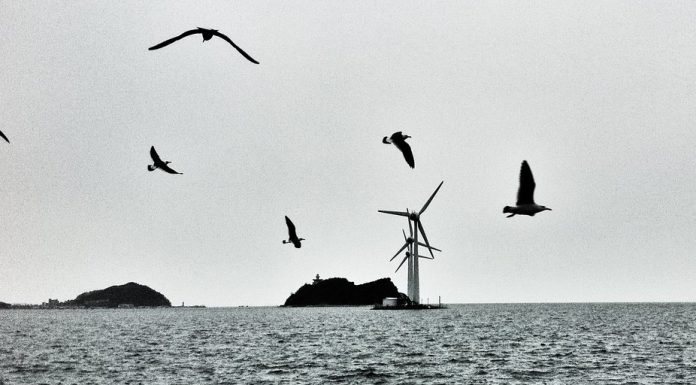(Vince Bielski, RealClearInvestigations) Icebreaker Wind, designed as the first offshore renewable power project in the Great Lakes, is backed by the usual supporting cast: energy development advocates and environmental groups like the Sierra Club and the Ohio Environmental Council.
What’s surprising is that much of the opposition is coming from other environmental groups, including the National Audubon Society and the Black Swamp Bird Observatory, that seek to protect birds from lethal collisions with turbines.
They notched a victory in May when Ohio regulators ordered that the wind farm would have to shut down at night, a restriction that effectively kills the project unless an appeal is successful, according to the developer.

The seven-year clash over Icebreaker exemplifies the growing tension among environmentalists as they weigh the costs of clean energy. The rapid rollout of renewable power is shattering old alliances, pitting green groups against energy projects meant to address climate change – a top priority of other environmental organizations. In a strange new twist, bird groups opposed to Icebreaker found themselves fighting side-by-side with local residents backed by coal mining giant Murray Energy Corp., an opponent of renewable energy mandates in Ohio.
Armed with litigators and wildlife experts, conservation groups have become formidable foes for the renewable energy industry that already faces headwinds from rural communities and the coronavirus recession that has slashed demand for power. In Maryland, a large coalition of environmentalists defeated a solar farm to protect a forest. In the California desert, they are jeopardizing several new projects to save an iconic tree.
The battle is complicated by another fact: While the benefits of any single renewable energy project are negligible in affecting the global climate, the environmental costs, even if they are also small, are palpable.
The Audubon Society lobbied for the nightime ban on Icebreaker’s operation to save an unknown but likely small number of birds. Yet the group rang the alarm bell in its 2014 climate change report, declaring that more than half of 588 North American species are endangered or threatened due to shifts in their geographic ranges.
As green vs. green conflicts crop up across the country, leaders of these groups that are accustomed to collaborating are reluctant to talk about the tensions that now divide them.
The Audubon Society, which isn’t normally press shy, turned down several requests to discuss its position of “conditional support” for Icebreaker. Leaders of Black Swamp and the Ohio Environmental Council did privately converse about their differences over the wind farm but details of those talks weren’t forthcoming.
“It’s a difficult trade-off for environmentalists,” says Michael Gerrard, a professor of environmental law at Columbia who represents communities that want renewable energy projects. “Wind turbines and certain kinds of solar installations can kill some wildlife. But that’s a small part of the big picture. We need a massive increase in renewable energy to address the climate problem so those wishing to protect wildlife should be more flexible.”
Environmentalists say that framing the issue as a tradeoff – birds or trees for clean energy – is wrong. They say the U.S. can have it all by locating wind and solar farms on rooftops, parking lots and degraded lands that have no other use.
“Let’s think about how we build out wind energy wisely rather than move ahead at all costs,” says Mark Shieldcastle, a wildlife scientist at Black Swamp Bird Observatory who gave expert commentary on Icebreaker’s potential danger to birds.
But that optimism isn’t shared by states aiming to cut carbon emissions to net zero in two decades. Although developers in New York and California are trying to site projects on less desirable property, there isn’t enough of it in the vicinity of transmission lines for the planned exponential growth in renewable energy projects. That means today’s mega wind and solar farms – a typical project covers several square miles – will inevitably disturb valuable ecosystems and wildlife and require trade-offs that some environmentalists are unwilling to accept.
“To decarbonize the grid, rooftops, brownfields and landfills are not enough,” says Shannon Eddy, executive director of the Large-scale Solar Association in California. “We also need to build in deserts, co-locate on farmland and get creative and make tough choices about where projects can go.”
In Maryland, environmentalists showed little interest in compromising on Georgetown University’s plan to put a solar farm in a forest. In a state with very little farmland available for renewable energy, Georgetown’s developer proposed clearing about 249 acres of mostly wooded property in Charles County for the project, while taking ambitious steps to minimize impacts to streams and wetlands.

Environmentalists, however, were outraged at the idea of cutting down trees for a solar farm. The Chesapeake Bay Foundation, a Sierra Club chapter, Audubon in Maryland and other groups campaigned against it. They met with university officials and testified before the Maryland environmental department, which heard from more than 80 people. The university’s estimate that the solar farm would reduce greenhouse gases far more than the existing forest absorbs didn’t seem to matter.
“There were too many ecological issues and consultation concerns with the developer to support this project,” says Rosa Hance, chair of the Maryland chapter of the Sierra Club. “Generally, the Sierra Club does not oppose solar projects.”
Maryland denied the permit last year, saying the developer failed to adequately address alternative sites and water quality issues. But Georgetown isn’t giving up. A spokeswoman says the university is committed to the robust deployment of renewable energy as part of its goal to cut fossil-fuel consumption.
In California, environmentalists are making parts of the desert – one of the world’s best locations for solar energy – off limits to developers. First they protected the threatened Desert Tortoise. Now it’s the Western Joshua tree.
The short, spike-leafed tree that populates the Mojave Desert is headed for extinction in coming decades due to climate change, fires and development, including solar farms, says Brendan Cummings, an attorney and conservation director at the Center for Biological Diversity. The center petitioned the California Fish and Game Commission to make the tree, which is actually a yucca plant, a candidate for the endangered species list. On Aug. 20, the commissioners suggested that they would soon approve the petition – a move that would safeguard the Joshua tree while regulators study whether to designate it.
“When planning solar projects, if there are Joshua trees there, it’s probably not a good site,” Cummings says. “The Joshua tree range represents a small fraction of the California desert, so there’s land that can be built on without touching a tree.”
The solar industry adamantly opposes the petition. A half dozen solar farms totaling 1,400 megawatts – enough to power hundreds of thousands of homes — that have permits or are in the process of getting them would be affected if the commission protects the tree. Some are slated to begin construction this year. The Solar Energy Industries Association and Large-scale Solar Association warned the commission in June that these projects would face costly delays and uncertainty, undermining California’s push to produce 100% of its power using clean sources by 2045.
“SEIA and LSA cannot emphasize strongly enough the negative impact that advancing the Joshua tree to candidacy will have on solar development in California,” the groups wrote.

In Ohio, bird conservation groups are threatening the future of wind power in the Great Lakes. The powerful winds that blow across the lakes make them ideal locations for projects like Icebreaker. If successful, the demonstration wind farm could turn Lake Erie into a renewable power mecca with more than 1,000 turbines and spur a buildout across the Great Lakes.
But millions of migratory bats and birds such as thrushes and warblers ride those winds, mostly at night. The Icebreaker controversy is over how many animals it will kill amid sharp declines in most North American bird species, primarily from the loss of habitat because of development and climate change.
Icebreaker’s small size and location reduces the danger for wildlife. Most migratory birds wouldn’t encounter its six turbines situated 8 to 10 miles offshore because they fly near land to avoid the long passage over the lake.
Still, questions remain about the volume of birds that fly over the lake in the project area at night, when they can’t see the turbines, and if they descend low enough to collide with the long spinning blades that have a diameter of 413 feet.
Icebreaker shows the difficulty renewable energy developers face in assessing the impact of wind and solar farms on wildlife, particularly birds, even when using state of the art scientific methods. After a range of studies were conducted, which mostly suggest that Icebreaker wouldn’t pose a big threat to birds, serious debates continue over the quality of the research.

The Lake Erie Energy Development Corp. (LEEDCo) tried and failed to answer the questions about avian exposure to its Icebreaker project because of the technical challenges of using marine radar to spot little birds flying at night, particularly during bad weather.


